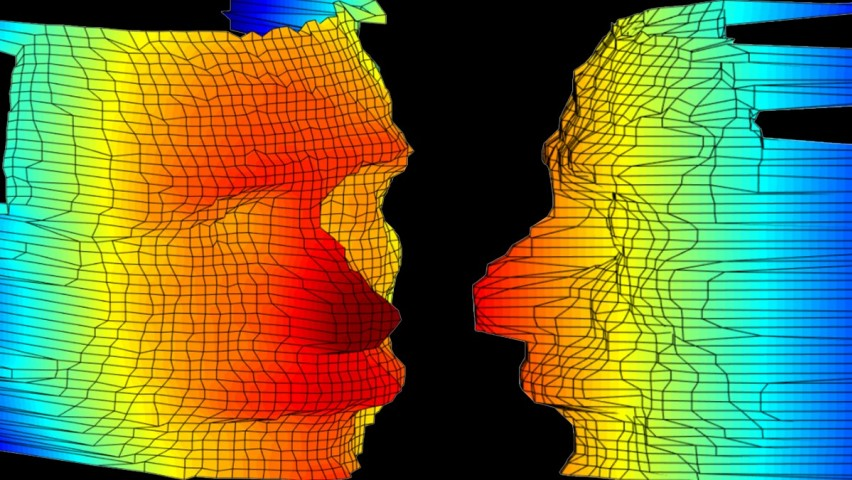Feb 25 2020
Scientists at Stevens Institute of Technology have developed a new 3D imaging system that utilizes the quantum properties of light to produce images that are 40,000 times sharper than existing technologies.
 Stevens Institute of Technology creates a quantum 3D imaging technique that paves the way for unprecedented performance for self-driving cars, medical imaging of the human retina, and deep-space communication. Image Credit: Stevens Institute of Technology.
Stevens Institute of Technology creates a quantum 3D imaging technique that paves the way for unprecedented performance for self-driving cars, medical imaging of the human retina, and deep-space communication. Image Credit: Stevens Institute of Technology.
This latest breakthrough paves the way for the first-ever LIDAR sensing and detection in medical imaging of the human retina, deep-space communications, satellite mapping systems, and self-driving cars.
Headed by Yuping Huang, director of the Center for Quantum Science and Engineering at Stevens Institute of Technology, the study tackles a 10-year-old issue associated with LIDAR. LIDAR fires lasers at remotely located targets and subsequently identifies the reflected light.
Although light detectors utilized in LIDAR systems are sufficiently sensitive to produce comprehensive images from only a small number of photons, it is very difficult to distinguish the fragments of laser light that are reflected from brighter background light like sunbeams. Photons are tiny light particles that can be encoded with data.
The more sensitive our sensors get, the more sensitive they become to background noise. That’s the problem we’re now trying to solve.
Yuping Huang, Director, Center for Quantum Science and Engineering, Stevens Institute of Technology
Huang’s study was published in an advanced online issue of Nature Communications on February 17th, 2020.
The new technology is the first real-world display of single-photon noise reduction utilizing a technique known as Quantum Parametric Mode Sorting, or QPMS for short. This technique was originally suggested by Huang and his research team in a Nature paper in 2017.
A majority of the noise-filtering tools typically clean up noisy images by using software-based post-processing. But the QPMS method checks the quantum signatures of light via unusual nonlinear optics to produce an exponentially cleaner image at the sensor level itself.
Identifying a photon that bears specific data in the milieu of background noise is like attempting to pick one snowflake from a blizzard; however, that is exactly what Huang’s research team has done.
Huang and collaborators elucidated a technique for imprinting particular quantum characteristics onto an outgoing beam of laser light and subsequently filtering the incoming laser light. This technique would allow the sensor to register only those photons that have corresponding quantum characteristics.
This results in an imaging system that ignores almost all unnecessary noisy photons but is remarkably susceptible to photons returning from its target. The researchers’ technique produces crisp three-dimensional (3D) images even when each signal-carrying photon is overwhelmed by many noisy photons by as much as 34 times.
By cleaning up initial photon detection, we’re pushing the limits of accurate 3D imaging in a noisy environment. We’ve shown that we can reduce the amount of noise about 40,000 times better than the top current imaging technologies.
Patrick Rehain, Study Lead Author and Doctoral Candidate, Stevens Institute of Technology
The hardware-based method may enable the use of LIDAR technology in noisy environments that do not permit computationally intensive post-processing. In addition, LIDAR technology could be integrated with software-based noise reduction to create even more improved results.
“We aren’t trying to compete with computational approaches—we’re giving them new platforms to work in,” added Rehain.
From a practical standpoint, QPMS noise reduction may enable the use of LIDAR technology to create precise and comprehensive 3D images at ranges of up to 30 km. In addition, the QPMS technique could be utilized for deep-space communication, where the intense glare of the sun would normally drown out remote pulses of laser.
But most fascinatingly, the technology may also allow scientists to more closely look at the most susceptible parts of the human body. By allowing almost noise-free single-photon imaging, the imaging system developed by the research team at Stevens Institute of Technology will help investigators to produce sharp and highly comprehensive images of the human retina using virtually imperceptibly faint beams of laser that will not impact the sensitive tissues of the eye.
The single-photon imaging field is booming. But it’s been a long time since we’ve seen such a big step forward in noise reduction, and the benefits it could impart to so many technologies.
Yuping Huang, Director, Center for Quantum Science and Engineering, Stevens Institute of Technology